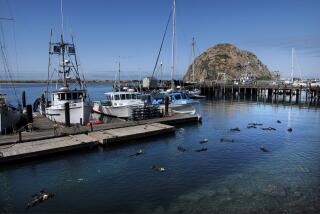Dirty Ocean Not an Option
There’s an eerie uncertainty among Orange County beachgoers, government regulators and city officials after spring surf brought a monthlong closure to half a mile of Huntington State Beach. Despite five years of study and the expenditure of more than $8 million, the question that remains unanswered is “Why are our beaches so filthy?”
After passage of a 1997 law that required regular testing of water at state beaches, officials quickly found all was not well in Surf City.
Five miles of beaches between Newport Beach and Huntington Beach were closed to swimming in the summer of 1999, and the impact of the closures on beach-related business was disastrous.
Research in progress by economists at USC and UC Berkeley shows that beach-related spending at Huntington state and Huntington city beaches was down more than $15 million in 1999 and almost $19 million in 2000 compared with 1998. As this summer quickly approaches, we must act to restore clean water and avoid further economic losses and damage to Orange County’s image.
What we know is that beach closures and chronic warnings may stem from two sources: urban runoff, a catchall phrase to describe water that flows across our cityscape to the ocean, and the discharge of sewage from the Orange County Sanitation District offshore at the Newport Beach/Huntington Beach bound- ary.
On top of these problems, the beaches are periodically closed when roots and grease clog pipes and sewage spills into waterways that lead to the ocean.
Action has been taken on urban runoff issues under new, wide-ranging and rigorous permits recently adopted by the state. Cities will be implementing measures with residents and businesses that will affect how driveways are cleaned and landscapes are maintained.
A similar commitment to improving the treatment of Orange County sewage has not been made. Orange County is one of only a handful of sanitation districts nationwide to be granted a federal waiver that allows the district to dump partially treated sewage into the ocean. District officials have justified their waiver based on the belief that their outfall pipe was sufficiently far offshore.
Now, these same officials cannot be so sure. In February, Blake Anderson, district general manager, wrote in a news release that the plume of waste water came “uncomfortably close” to the shoreline at Newport Beach--within half a mile. Coincidently, a paper was published in an academic journal in March that showed how the plume potentially could move to within half a mile of the shore and to depths as shallow as 65 feet.
In April, Orange County closed a half-mile stretch of beach at Magnolia Street to swimming because of high bacteria counts and uncertainty about their source. The closure remained in effect for one month.
In response, the district has committed to disinfecting its waste water, and we support this decision. This will finally bring the district in line with the minimum disinfection efforts of every other ocean sewage discharger in California.
To avert beach closures and continuing erosion in public confidence, we urge regulators to expedite the permitting and environmental review process. We must take action now to ensure our beaches are not closed again.
Beyond this quick fix, we are asking the district to invest in the infrastructure that will treat sewage to secondary standards, in line with other major facilities, such as the Hyperion sewage treatment plant in Los Angeles.
With secondary treatment, we can ensure more complete destruction of disease-causing bacteria and viruses. If the district goes forward this fall with an application for renewal of the waiver, we urge the Environmental Protection Agency, the California Regional Water Board and the California Coastal Commission to reject it.
While many argue that secondary treatment is too costly, we believe the public wants clean beaches and is willing to pay for them. USC and UC Berkeley researchers found that more than 66% of Southern Californian households with at least one beachgoer would be willing to pay $100 annually to prevent beach closures resulting from sewage discharge.
The willingness of the public to pay for clean beaches is well in excess of what the district estimates it will cost to go to secondary treatment. Anderson recently stated that the cost for the district to upgrade treatment facilities would cost residents 5 cents per day or less than $20 per year.
With more than half of all households in the region claiming at least one beachgoer, there should be plenty of public support for the district to increase its protection of our valuable beaches. After all, what are Huntington Beach and Newport Beach without beaches that are safe for swimming and surfing?
More to Read
Sign up for Essential California
The most important California stories and recommendations in your inbox every morning.
You may occasionally receive promotional content from the Los Angeles Times.









